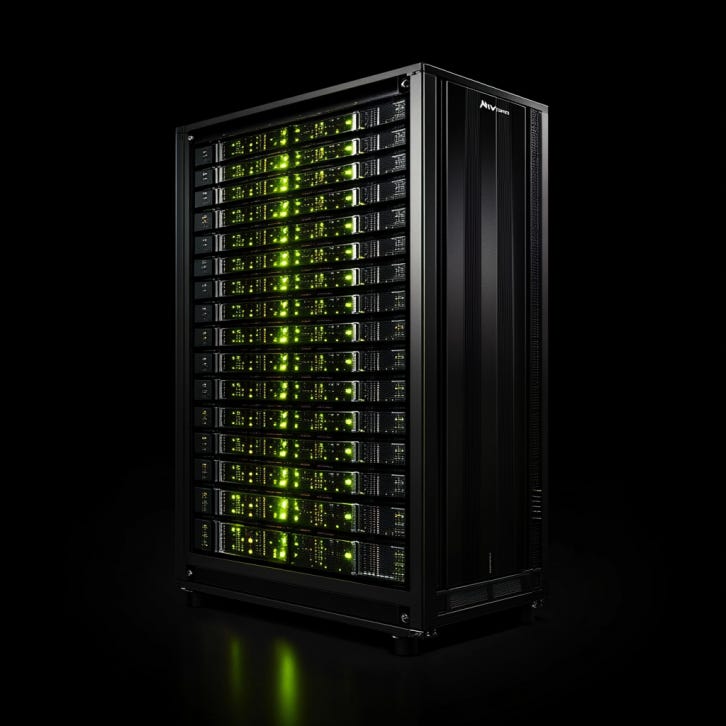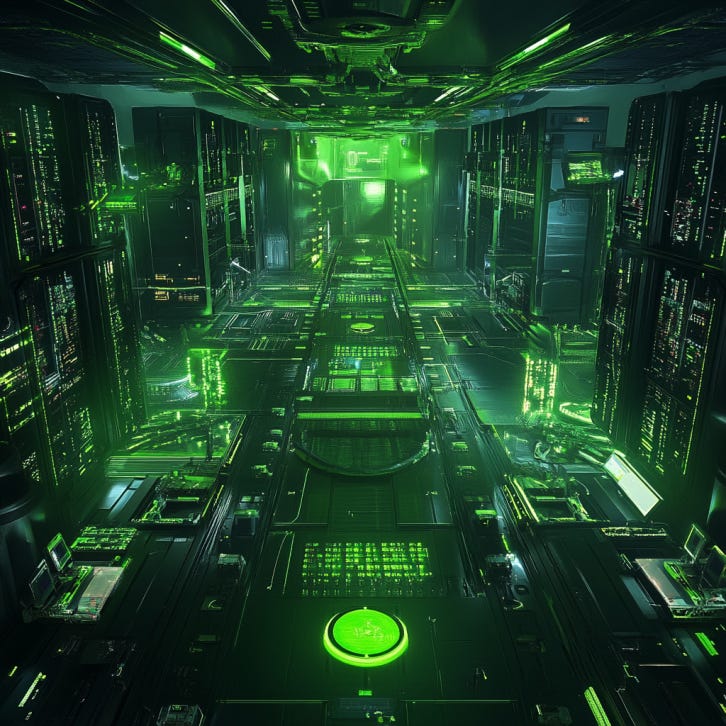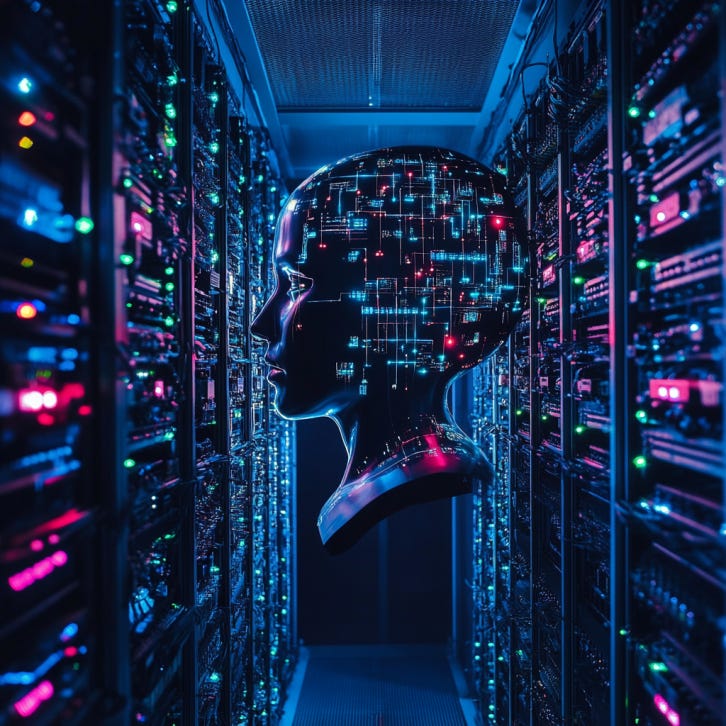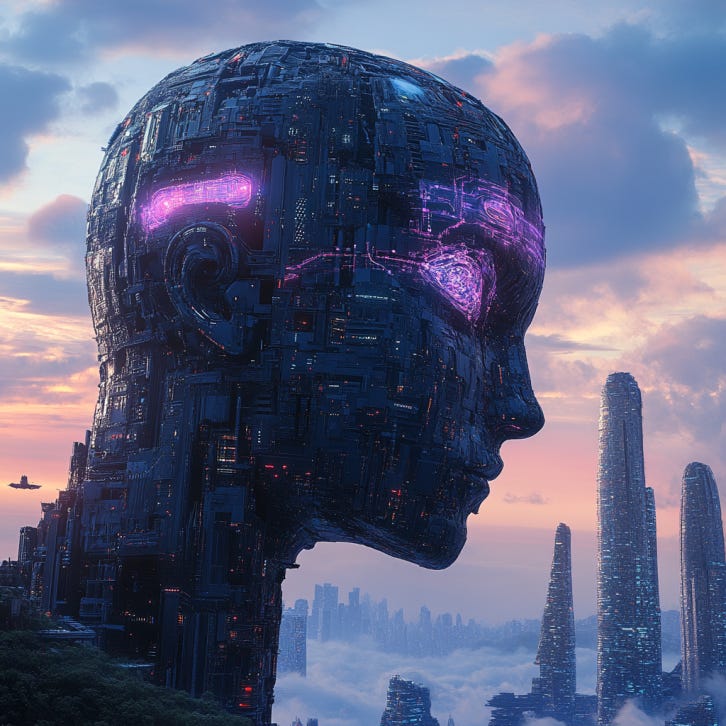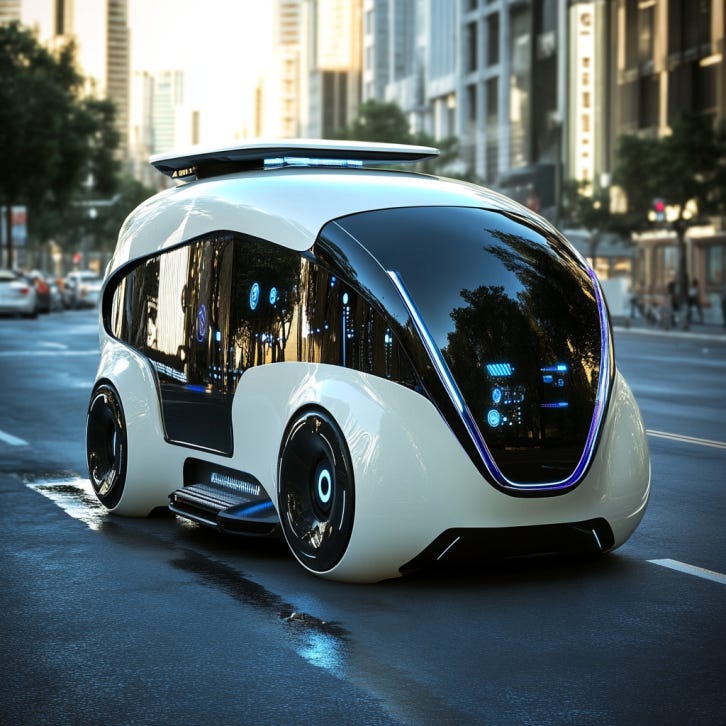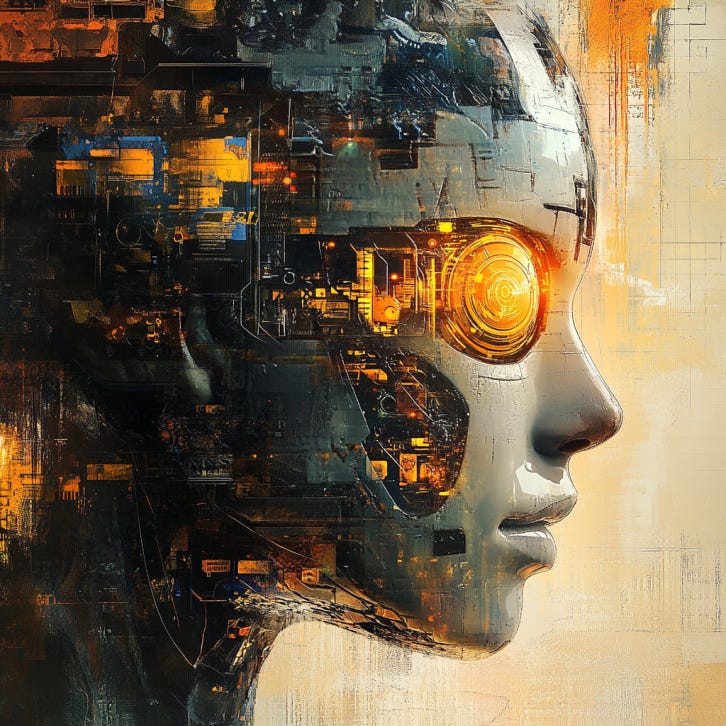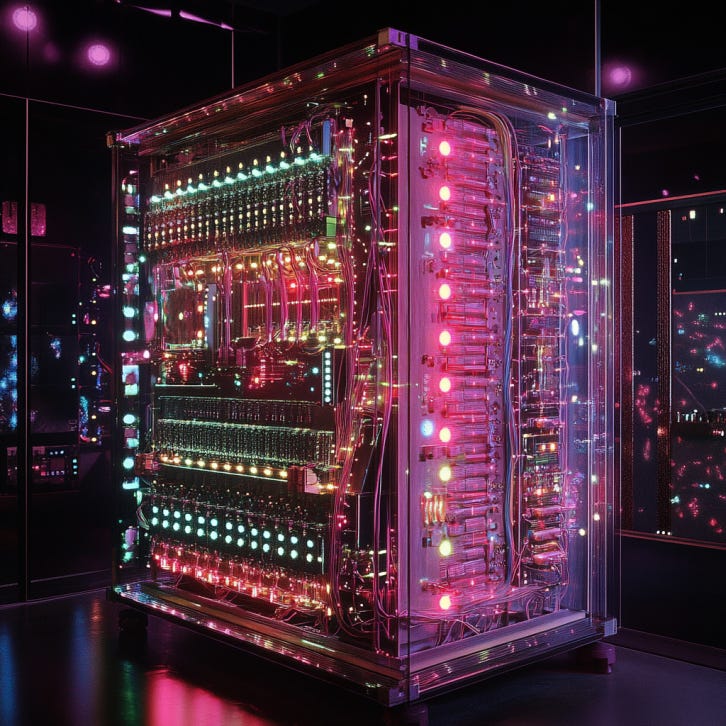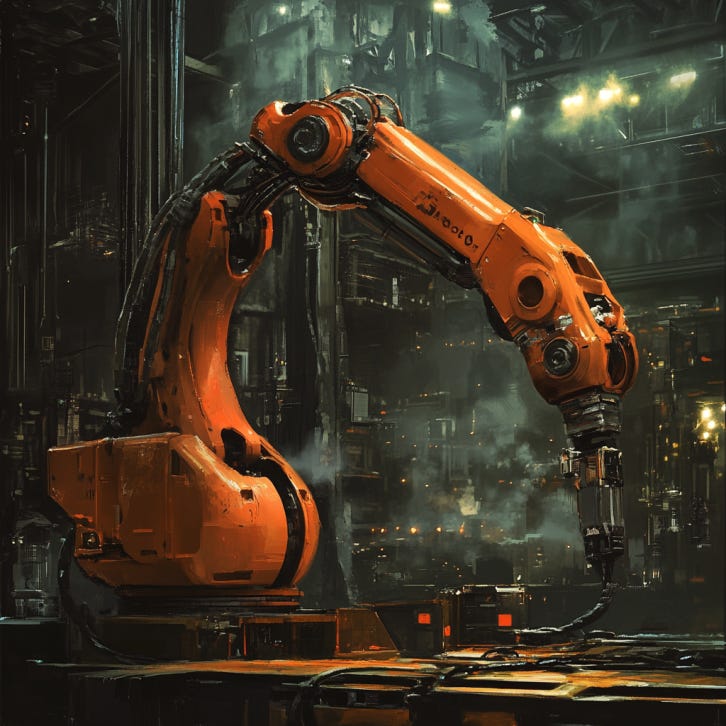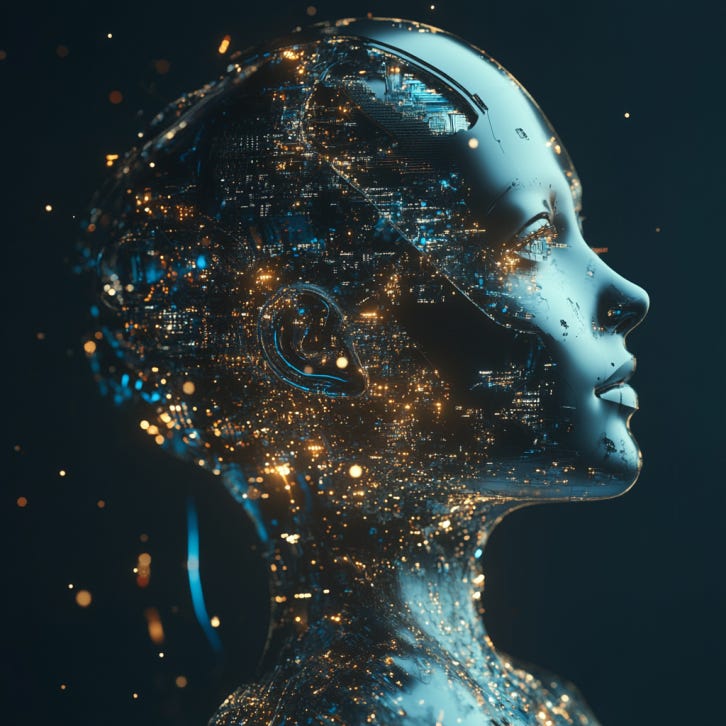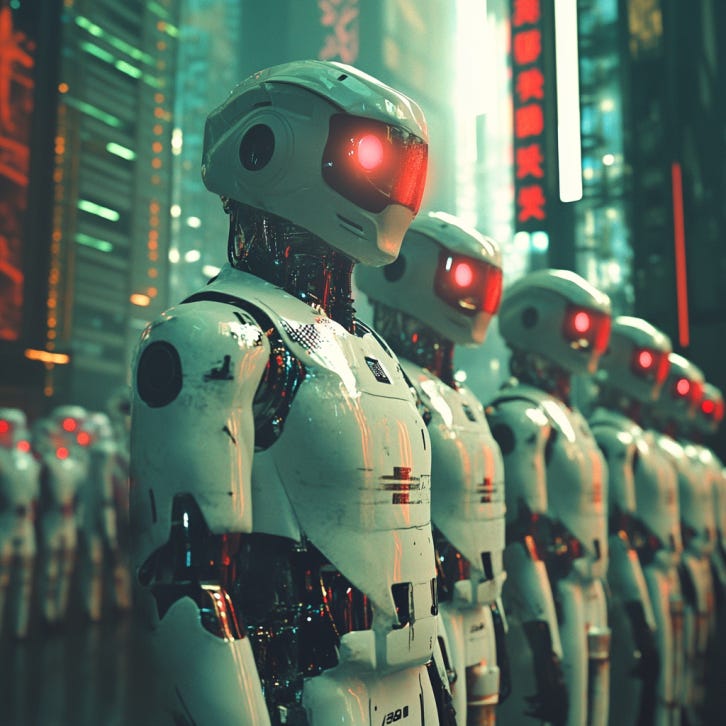9 Key Highlights from Jensen Huang's CES Speech (2025): NVIDIA's Future is AI Agents, Robotics, Digital Twins
All the major highlights & interpretations of Jensen Huang's (NVIDIA CEO) speech at CES 2025
NVIDIA CEO Jensen Huang took the CES 2025 stage with a keynote that drew the industry’s gaze to a new chapter in AI-driven computing.
From the next-gen Blackwell GPUs for both consumers and data centers to advanced robotic platforms powered by Omniverse and Cosmos, his announcements painted a future where AI is seamlessly woven into gaming, enterprise workflows, and industrial simulations alike.
Most people following NVIDIA closely aren’t surprised by these announcements… NVIDIA is far ahead of the competition in hardware, software, R&D, etc. and there’s no slowing down - just pure acceleration.
Everyone is focused on their chips for AI (LLMs) but most don’t understand that they are becoming the staple of the robotics ecosystem (software, brains, simulations, etc.), a major player in autonomous vehicle tech, AI agents, and they have something to offer everyone (enterprises, gamers, general consumers, etc.).

The Evolution: How We Got Here
“We wanted to build computers that can do things that normal computers couldn’t.” – Jensen Huang, reflecting on NVIDIA’s founding vision
From the very beginning, Jensen framed the keynote around NVIDIA’s historical milestones—how each breakthrough laid the groundwork for the AI transformations happening today. He cited:
Early GPU design in the 1990s, making PC gaming consoles possible.
1999: The world’s first programmable GPU, which sparked the modern computer-graphics revolution.
2006: The invention of Cuda, a “difficult to explain” concept at first, which let GPUs tackle more than just graphics.
2012: AlexNet on GPUs, viewed as the launching point of modern deep learning.
2018: Google’s Transformer architecture (BERT), which became the catalyst for large language models and “completely changed the landscape for computing.”
“AI was not just a new application with a new business opportunity... it was going to fundamentally change how computing works.” – Jensen Huang, underscoring the shift from CPU-based software to AI-driven systems
1. Blackwell Consumer GPUs (RTX 50 Series)
“And now for the Blackwell family... 5070 at $549 with the performance of a 4090.” – Jensen Huang, announcing new pricing tiers
What It’s Used For
High-End Gaming: Real-time ray tracing and “neural rendering” (DLSS frame generation).
Creative Work: Video editing, 3D design, and AI-accelerated content creation.
Local AI Inference: These GPUs have up to 4 PFLOPs of AI horsepower, making them viable for running large language models locally (in smaller scales).
Price and Variants
RTX 5070: $549 (matching last-gen 4090 performance)
RTX 5090: ~2× performance of 4090 (~$1,999)
NVIDIA Software and Ecosystem
DLSS Next-Gen: Extends from upscaling to entire frame synthesis (predicting future frames, not just intermediate pixels).
RTX Portal (developer suite): Continues support for path tracing, photoreal lighting, and tight integration with major game engines (Unreal, Unity).
Key Implications
Mass Adoption of AI-Driven Rendering: This generation cements “neural rendering” as the new standard. Expect game studios to design gameplay and visuals assuming half or more of the final frames are generated by AI.
Local AI Acceleration: An RTX 50 GPU can serve as a personal testbed for smaller-scale generative AI tasks, bridging a gap that used to require dedicated workstation cards or cloud.
2. Blackwell Data Center & HPC “Token Factories”
“Every single data center is limited by power... If the perf-per-watt of Blackwell is 4× our last generation, then we reduce the cost of training these models by a factor of three.” – Jensen Huang, on the economics of large-scale AI training
What It’s Used For
Massive LLM Training: Next-gen GPT-level or Gemini-level models requiring trillions of tokens in training.
AI-Enhanced Supercomputing: HPC centers for science, biotech, finance, where classical workloads now augment or embed neural networks (e.g., protein folding, climate modeling).
Mega-Scale Inference: Running “agentic AI” that does multi-step reasoning, internal dialogue, retrieval from knowledge bases, etc.
Cost and Deployment Models
A single Blackwell-based “MVLink 72” supernode could run $10–30 million in capital cost (though Jensen didn’t name a price, past DGX SuperPODs suggest 7–8 figure investments).
OEMs and hyperscalers (Dell, HPE, Supermicro, AWS, Azure, GCP) will incorporate these GPUs into turnkey AI servers starting in early 2025.
NVIDIA Software and Ecosystem
CUDA + HPC SDK: Foundation for scientific code, large-scale model parallelism, and optimized math libraries (cuBLAS, cuDNN, etc.).
NVIDIA AI Enterprise: Includes “Triton Inference Server,” “NeMo,” “Base Command,” etc. for managing AI training lifecycles.
Foundational Model Libraries: Llama Neotron (fine-tuned Llama), plus domain-specific NIMs for speech, vision, language, digital biology.
Key Implications
Lower Cost/Token: With 3–4× better perf-per-watt, training 10× bigger models or performing more chain-of-thought inference becomes feasible at stable or reduced budgets.
Data Center Overhaul: Traditional CPU-based server racks can’t keep up with the scale. Expect further transformation in colocation facility design (liquid cooling, specialized power distribution).
Expansion Beyond Text: “Token factories” will handle not just text but video tokens, robotics action tokens, and more.
Related: NVIDIA GPUs vs. Custom Chips from Hyperscalers: Who Wins Out?
3. Agentic AI in the Enterprise (NVIDIA NeMo & NIMs)
“Your IT department is going to become kind of like AI agent HR.” – Jensen Huang, on the new model of digital employees
What It’s Used For
“Digital Employees”: Domain-specific AI “agents” that respond to user queries, craft reports, or automate internal workflows.
Vertical Applications: Finance (due diligence bots), healthcare (clinical summary agents), or manufacturing (supply chain optimization).
Cross-Tool Orchestration: An AI agent can retrieve data from CRMs, fetch knowledge-base articles, or even run Python scripts to solve complex tasks.
Cost and Integration
NeMo is generally part of NVIDIA AI Enterprise licensing or used on a cloud consumption model.
Enterprises can host these models on-prem (DGX or Project Digits) or in public cloud.
NVIDIA Software and Ecosystem
NIMs (NeMo Microservices): Ready-to-deploy containers with pretrained models (vision, speech, language, etc.) optimized for GPU inference.
Guardrailing & RLHF: NeMo includes frameworks for domain adaptation, human feedback loops, and policy enforcement.
Key Implications
AI as an Employee: Instead of installing new “version 2.0 software,” you hire or “spin up” an AI agent that has read your manuals, tested on your data, and is given explicit boundaries.
Ecosystem Play: Partners like ServiceNow, SAP, Cadence, etc. are embedding these frameworks into their platforms—accelerating enterprise adoption.
Scale & Skills: Might require “prompt engineers” or “agent ops specialists” who oversee large fleets of digital employees.
Related: Top 30 Software Companies for AI Agents: Highest ROI (%) Projections
4. Cosmos: World Foundation Model for Physical AI
“Cosmos can bring our visions to life... generating real-time tokens for physically plausible future states.” – Jensen Huang, on bridging AI with real-world physics
What It’s Used For
Synthetic Data Generation: For training robotics or autonomous vehicle (AV) perception systems with realistic lighting, shadows, friction, collisions.
Predictive Simulation: Generating “multiverse” outcomes (e.g., if a robot sets a box on a table, will it slide off?).
Captioning + 3D Reasoning: Cosmos can ingest real-world video and produce detailed frames or text describing dynamic motions in physically consistent ways.
Open Licensing & Cost
NVIDIA announced Cosmos is open-licensed on GitHub. The model presumably requires big GPU clusters (like DGX or Blackwell) for training or large-scale inference.
Actual operational cost depends on how extensively you use it to generate data. For smaller tasks, partial cloud usage can suffice; for large autonomy projects, you might need full HPC infrastructure.
NVIDIA Software and Ecosystem
Omniverse Integration: By linking Omniverse’s physically-based rendering (PBR) and real-time physics engine with Cosmos, you ground the generative model in a truth-checked simulation.
Data Pipeline: COSMOS includes Cuda-accelerated preprocessing for large-scale video ingestion, plus the ability to export synthetic data to training frameworks (e.g., PyTorch, TensorFlow).
Key Implications
Beyond 2D: AI’s next major leap is understanding and generating 3D (and 4D) worlds, not just text or flat images.
Robotics Acceleration: The biggest barrier—collecting real-world “fails”—shrinks because Cosmos can generate near-infinite variations of physically accurate scenarios for training.
Industrial Simulation: Factories, warehouses, and self-driving solutions become less reliant on risky or time-consuming real-world trials, speeding up R&D cycles.
5. “Three Computers” for Robotics & AV
“We build three fundamental computers in every robotics project: one to train the AI (DGX), one to test and refine (Omniverse), and one to run in the machine (AGX).” – Jensen Huang, describing the architecture needed for autonomy
What It’s Used For
Autonomous Vehicles: Train vision and planning networks on DGX, refine them in Omniverse + Cosmos, then deploy on Thor or Orin (AGX computers) inside the car.
Factory Robots & AMRs: The same pipeline for picking/packing robots, forklift automation, or assembly-line arms.
Cost & Deployment
DGX: Typically $150k–$300k+ per node (with variations for DGX A100, H100, etc.).
Omniverse: Software suite licensed under various enterprise agreements or used with GPU-based hardware.
AGX Modules: Range from sub-$1,000 (Jetson-level) to tens of thousands of dollars for high-end Thor in automotive.
NVIDIA Software and Ecosystem
Isaac Sim (part of Omniverse) for physically accurate robotics simulation.
DriveWorks & Drive OS for automotive.
Reinforcement Learning + Synthetic Data pipelines bridging HPC training with real-world deployment.
Key Implications
Standardization: Car OEMs (BYD, Toyota, Mercedes, Lucid) unify on a single architecture, streamlining R&D.
Faster Iteration: Rapidly patch or upgrade an AI driving policy by spinning new training cycles in the data center, verifying in simulation, then rolling out OTA updates to AGX modules in vehicles.
Functional Safety: Achieving ISO 26262 ASIL-D (mentioned for Drive OS) highlights the push toward robust, certifiable AI for critical robotics tasks.
6. Isaac Groot: Scaling Robot Training Data
“Developers... can capture motion trajectories through a handful of teleoperated demonstrations, then use Groot Mimic to multiply these trajectories into a much larger dataset.” – Narration of Isaac Groot’s core feature
What It’s Used For
Humanoid / Manipulator Robots: Teaching new tasks (lifting boxes, assembling parts) without manually guiding a robot thousands of times.
AMRs (Autonomous Mobile Robots): Generating path variations, obstacle scenarios, lighting changes, etc.
Reinforcement Learning: Creating “AI feedback loops” to refine policies in simulation.
NVIDIA Software and Ecosystem
Teleoperation Tools (Groot Teleop): Let a human operator “step into” a digital twin via AR/VR (e.g., Apple Vision Pro) and record movements that the AI can mimic.
Domain Randomization (Groot Gen): Adjust environment textures, lighting, friction so that the robot policy generalizes better.
Integration with Omniverse + Cosmos: The synergy ensures physically accurate expansions of each demonstration.
Key Implications
Massive Efficiency Gains: One real-world demonstration → thousands of unique training samples, saving huge labor costs.
Towards General-Purpose Robots: If a robot can be taught tasks quickly, the threshold for ROI improves, fueling new consumer or industrial robotics.
Competitive Edge for Robotics OEMs: Companies that adopt these pipelines can iterate faster and handle more complex tasks.
Related: NVIDIA Robotics Ecosystem: 5 Projects Shaping the Future
7. Project “Digits”: Personal AI Supercomputer
“This is NVIDIA’s latest AI supercomputer. It’s an AI supercomputer in a small form factor... you can access it like a cloud supercomputer, or run it as a Linux workstation.” – Jensen Huang, unveiling Project Digits
What It’s Used For
Local Large Model Fine-Tuning: Developers can adapt large language models or specialized domain models without paying for continuous cloud GPU hours.
On-Prem HPC Tasks: Data science, 3D rendering, simulation workloads that used to demand a full-scale cluster.
AI Startups & Labs: A perfect “lab cluster in a box” for research, prototyping, or sensitive data that can’t go to public cloud.
Cost & Hardware Details
Price: Jensen did not announce a precise cost. Based on previous “workstation-class” solutions (e.g., DGX Station at $50k+), a conservative estimate would be tens of thousands of dollars.
Specs:
Grace CPU (co-designed with MediaTek for SoC synergy)
Blackwell GPU (“GB110,” smaller than the big HPC dies but still potent)
High-Speed Networking: ConnectX or similar to link multiple Digits boxes or attach to local HPC storage.
Form Factor: Desktop or “tower” sized. Potentially stackable (“Double Digits”) for scaled-out mini-clusters.
NVIDIA Software and Ecosystem
Full HPC + AI Stack: CUDA, TensorRT, Triton Inference Server, NeMo, Isaac, Omniverse tools (all validated on the same drivers).
dgx-cloud-like Admin Tools: Potential for monitoring, container orchestration, job scheduling as if it’s a mini data center.
Key Implications
Democratizing HPC: You don’t need to rent cloud superclusters for every experiment. A small lab can own an on-prem HPC box for continuous dev/test.
Edge AI Booster: Edge deployments that require HPC but can’t rely on cloud (due to latency, data sovereignty, or connectivity) now have a self-contained solution.
Competition with Workstations: This goes beyond a standard workstation GPU—Digits is pitched as a mini supercomputer with HPC networking, advanced CPU-GPU synergy, and enterprise-grade software.
8. Industrial Digital Twins & KION–Accenture Partnership
“We’re partnering with KION, the world’s leading warehouse automation solutions provider, and Accenture... to tackle the $1 trillion warehouse and distribution center market.” – Jensen Huang, on the push to digitalize logistics
Key Use Cases & Details
Warehouse & Logistics Optimization: Using Omniverse for large-scale simulation of distribution centers, analyzing complex interactions among workers, autonomous forklifts, and storage systems.
“MEGA” Blueprint: NVIDIA’s reference architecture for industrial digital twins that integrates with KION’s warehouse management software.
Robot Fleet Coordination: Digital twins allow a fleet of AMRs (Autonomous Mobile Robots) to be tested across infinite variations of floor layouts, shifting demand patterns, or seasonal product mixes.
NVIDIA Software & Integration
Omniverse + Isaac Sim: Precisely simulates robot behaviors, forklift trajectories, potential bottlenecks.
Cosmos: Used to introduce domain-randomized scenarios (different lighting, forklift speeds, human traffic) for robust AI training.
Implications
Reduced Operational Surprises: Companies can experiment with new floor plans or robot workflows in simulation before rolling them out physically.
Cost and Time Savings: Risk of warehouse downtime or reconfiguration errors drops dramatically, accelerating ROI on automation.
Standardized Industrial Workflow: By adopting NVIDIA’s “digital twin blueprint,” major system integrators (like Accenture) can replicate best practices globally.
9. Native Windows AI: WSL2 as a First-Class AI Dev Platform
“Our focus is to turn Windows WSL2 into a target platform we will support and maintain for as long as we shall live.” – Jensen Huang, emphasizing local AI development on Windows
Key Use Cases & Details
Local Development & Prototyping: Machine learning engineers, data scientists, and even advanced hobbyists can install NVIDIA’s CUDA stack inside WSL2.
Seamless Translation of Cloud Workflows: The same containerized AI microservices (NIMs, Nemo-based solutions) that run on DGX or cloud can now run locally on a Windows machine with a GeForce or RTX card.
Accelerated Creative Tools: Artists or game modders on Windows can leverage stable diffusion, text-to-3D, or other generative AI tasks without leaving their primary OS.
NVIDIA Software & Integration
Full CUDA Compatibility: WSL2 passes GPU instructions directly to the driver, allowing everything from
cuDNNto advanced HPC libraries.Triton Inference Server & Nemo on Windows: Dev teams can develop and test GPU-accelerated AI services locally, then push them to the cloud or an on-prem HPC cluster.
Implications
Democratizing AI for 100s of Millions of PCs: Not everyone wants (or can afford) a dedicated Linux workstation—WSL2 lowers friction for AI dev on consumer-grade Windows.
Streamlined Enterprise Pipeline: Windows-based corporate environments can unify dev/test cycles with the same frameworks used in production HPC.
Boosted Ecosystem of AI Apps: Expect more Windows apps to integrate local AI inference for advanced features (like real-time video upscaling, voice AI, or on-device LLMs).
Brief Additional Takeaways (NVIDIA CES 2025)
Automotive Partnerships
Toyota joins BYD, Mercedes, Lucid, Volvo in adopting NVIDIA’s Thor or Orin SoCs.
High emphasis on ISO 26262 ASIL-D safety for Drive OS—vital for advanced driver assistance systems (ADAS) and fully autonomous drive.
Laptop GPUs
RTX 50 Laptop at $1299 can match a desktop 4090 thanks to heavy AI frame generation.
Possible new sweet spot for portable gaming, content creation, or on-the-go AI dev.
Manufacturing Scale
One MVLink 72 HPC system weighs over a ton, uses two miles of copper cables—indicative of HPC complexity.
45 factories worldwide produce these systems, then they’re partially disassembled/shipped for final data center assembly.
Future “Self-Talk” Workloads
Jensen anticipates that advanced agentic AI will ingest & generate tokens at far higher rates during internal reasoning.
This intensifies the demand for large compute clusters even for inference, not just training.
Final Wrap-Up: Huang CES 2025
From consumer GPUs that push “neural rendering” into the mainstream, to data-center-scale “token factories” powering the next leaps in large-language-model AI, Jensen Huang’s 2025 keynote laid out a comprehensive vision:
Agentic AI as a new digital workforce in enterprises;
Omniverse + Cosmos forging a new era of physical AI simulation;
Robotic development accelerating via synthetic data;
On-prem HPC made accessible via Project Digits;
And a vast ecosystem push (through Windows WSL2, KION–Accenture digital twins, and expansions into automotive).
All combined, these announcements underscore NVIDIA’s top-to-bottom platform approach—covering everything from thin-and-light laptops to exaflop-scale HPC—aimed at driving the next decade of AI-enabled computing.


